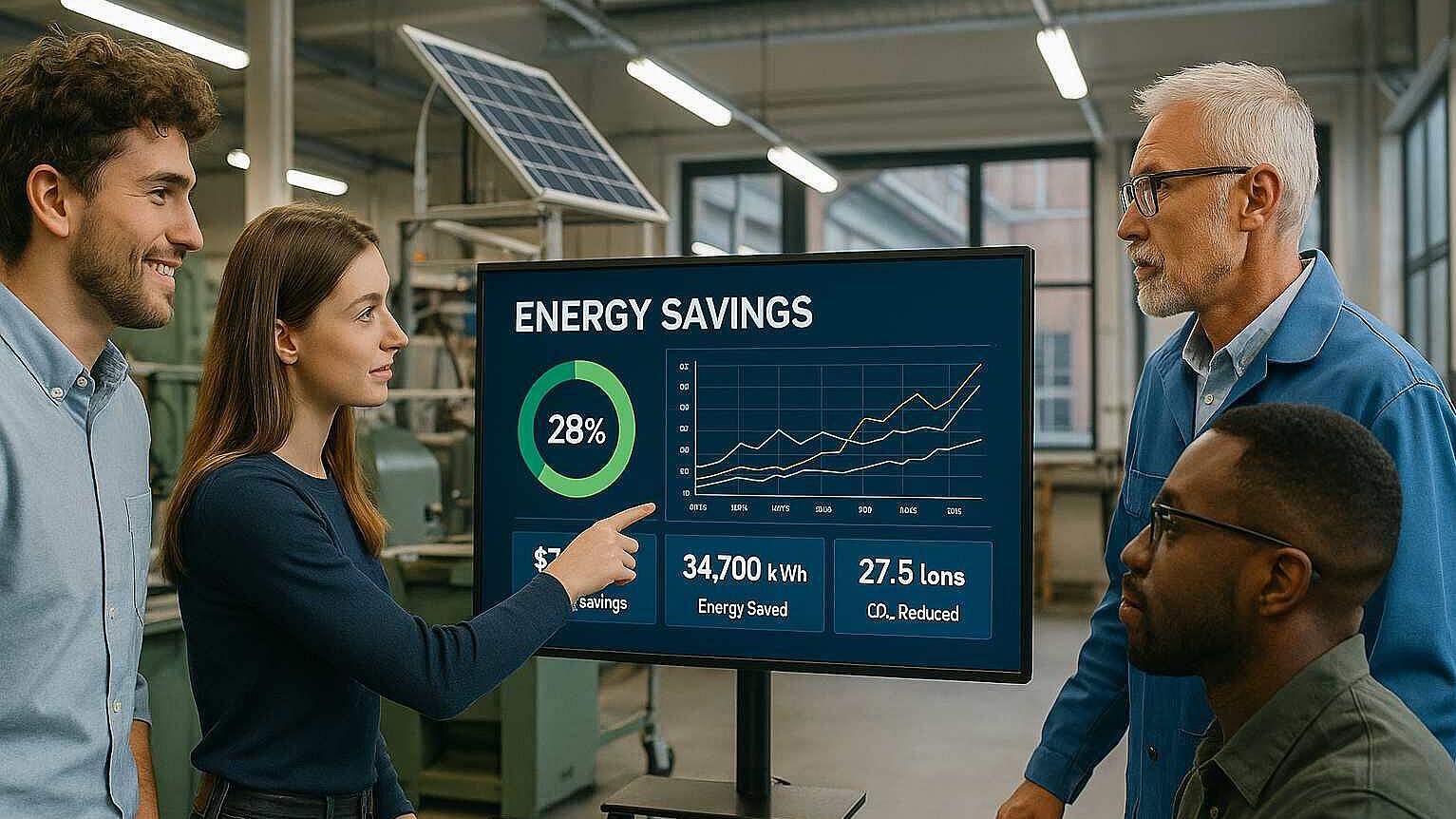 Energy Efficiency
Energy EfficiencyUnlocking Energy Efficiency in SMEs: Lessons from Seven European Projects
Summary
Small and medium enterprises (SMEs) represent 98.9% of EU businesses and account for around 13% of Europe's total energy demands. Despite the significance of their combined energy footprint, many SMEs have not embraced full energy efficiency due to various challenges including financial constraints, lack of knowledge about available technologies and government incentives, time pressures of daily operations, and cultural resistance to perceiving energy efficiency as beneficial. Projects like SPEEDIER, SMEmPower Efficiency, and E2Driver, however, have demonstrated that these challenges can be overcome through targeted training, energy audits, and leveraging external expertise. These approaches enable SMEs to develop energy strategies, appoint energy managers, and utilize grants. Collaboration across supply chains, as seen in the ICCEE project within the food and beverage sector, reveals further potential for energy savings and cost reductions. Beyond economic benefits, SMEs are motivated to improve energy efficiency for a greener image, long-term resilience, and employee engagement. The paper suggests the importance of national and EU support programs, customized training, and holistic policy interventions to promote energy efficiency within SMEs. The paper also highlights the opportunities present for students and young professionals in the field to contribute to this transformation. To enhance knowledge and engagement, it encourages the use of the Enerwhizz mobile quiz game.
Open full article
Unlocking Energy Efficiency in SMEs: Lessons from Seven European Projects
Imagine you’re the manager of a small factory in Ireland, juggling tight budgets, rising energy bills, and a team that’s more focused on daily production than on switching to LED lights or smart HVAC systems. Now multiply that scene by millions across Europe—because small and medium enterprises (SMEs) make up 98.9% of all businesses in the EU and are responsible for a significant chunk of energy use. Yet, despite their potential to drive major energy savings and slash carbon emissions, most SMEs have yet to fully embrace energy efficiency.
So, what stands in their way, and how can they leap ahead? The answer, as revealed by seven major European projects, lies in a mix of innovation, collaboration, and smart support. Here’s what students, young professionals, and change-makers need to know.
The Energy Landscape for SMEs: A Mixed Bag of Challenges
European SMEs are a diverse crowd—manufacturers, food processors, educators, retailers—spread across more than a dozen countries. While their individual energy footprints may seem small, together they represent about 13% of Europe’s total energy demand. Even modest efficiency gains can translate into massive continent-wide benefits, helping the EU hit its target of a 32.5% improvement in energy efficiency by 2030.
But here’s the catch: most SMEs struggle with the resources and expertise needed to upgrade equipment or optimize processes. Many haven’t appointed an energy manager, set energy reduction targets, or conducted an audit in years. Common hurdles include:
- Financial constraints: Limited capital for investments and uncertainty about payback periods.
- Knowledge gaps: Unfamiliarity with available technologies, government incentives, and best practices.
- Time pressures: Energy efficiency often takes a back seat to daily operational demands.
- Cultural inertia: For some, especially in sectors like food or manufacturing, energy efficiency can be seen as a “burden,” not a benefit.
Yet, as projects like SPEEDIER, SMEmPower Efficiency, and E2Driver have shown, these challenges are not insurmountable.
Training, Audits, and the Power of External Expertise
A breakthrough insight from the seven projects: targeted training and energy audits can spark real change.
For example, the SMEmPower Efficiency project found that when SMEs received hands-on training, they were more likely to develop energy strategies, appoint energy managers, and take advantage of grants or incentives. Workshops and peer-to-peer learning boosted both skills and motivation.
The SPEEDIER project, meanwhile, revealed that many SMEs are open to outsourcing energy management to external consultants—especially when the services are bundled as “one-stop-shops” that combine audits, training, financing advice, and impact monitoring. This model reduces the hassle and uncertainty for busy managers.
Notably, the E2Driver project tailored training specifically for the automotive sector, using both traditional workshops and digital platforms. Employees showed strong interest in practical workshops, and low-risk upgrades like better lighting or efficient compressed air systems were prioritized for their quick payback.
Collaboration Across Supply Chains: The Hidden Multiplier
One eye-opening discovery: collaboration between SMEs in the same supply chain unlocks even greater savings.
Take the ICCEE project in the food and beverage sector. Instead of just optimizing one company’s cold storage, they looked at the entire cold chain—from processing to logistics to retail. When businesses coordinated energy-saving measures, the ripple effects included reduced costs, lower emissions, and more competitive products on store shelves.
This “team sport” approach doesn’t just save energy; it builds trust and know-how across sectors and countries.
Drivers for Change: Beyond Economics
So what motivates SMEs to invest in energy efficiency? Beyond direct financial savings (which can be huge—a €500 annual saving might be equivalent to €30,000 in new sales for some firms!), companies also respond to:
- A “green” image: Many SMEs see sustainability as a competitive edge, helping them attract new customers or meet supply chain requirements.
- Long-term resilience: Energy efficiency reduces vulnerability to price shocks and regulatory changes.
- Capacity building: Training empowers employees at all levels to identify savings, boosting engagement and productivity.
However, the research also shows that removing barriers isn’t enough. Successful change depends on building an energy-aware culture—supported by ongoing training, visible management commitment, and peer networks.
Looking Ahead: Policy, Tech, and You
What’s the way forward? The research suggests several high-impact actions:
- National and EU-level support: Programs offering free or subsidized audits, grants, and streamlined financing can dramatically boost SME participation.
- Customized training: Content should be tailored for different roles—owners, managers, technicians—maximizing relevance and uptake.
- Holistic policies: Policymakers should design interventions that address financial, organizational, and behavioral barriers all at once.
- Wider adoption of audits: Making energy audits routine—even voluntary—creates a data-driven foundation for improvement.
For students and young professionals, this is a field brimming with opportunity. From consultancy and energy management to digital solutions and supply chain innovation, your skills are needed to drive the transformation.
Ready to Test Your Knowledge?
Want to learn more—and have fun in the process? Try out Enerwhizz, the multilingual mobile quiz game where you can compete in 45-second rounds, climb league tables, complete missions, and win gems, prizes, and ET coins. It’s a fast, competitive way to sharpen your energy expertise and join a community of future leaders. Play Enerwhizz now!
Conclusions
SMEs are at the heart of Europe’s energy transition. With tailored support, accessible training, and a spirit of collaboration, they can overcome financial and knowledge barriers to unlock major energy savings. This isn’t just about compliance—it’s about building competitive, resilient, and sustainable businesses for a new era. Whether you’re an aspiring energy auditor, a startup founder, or a policymaker-in-training, your ideas and action can help shape the future of energy efficiency in SMEs across Europe.
Sources & more…
More on Energy Efficiency in SME: https://www.researchgate.net/publication/368894731_Challenges_and_opportunities_for_improving_energy_efficiency_in_SMEs_learnings_from_seven_European_projects
More on D2050, the underlying EU project, check via “all EEIP projects”: https://projects.ee-ip.org/#ongoing-projects
More information on the EnerWhizz mobile quiz game, check: https://www.enerwhizz.info/



